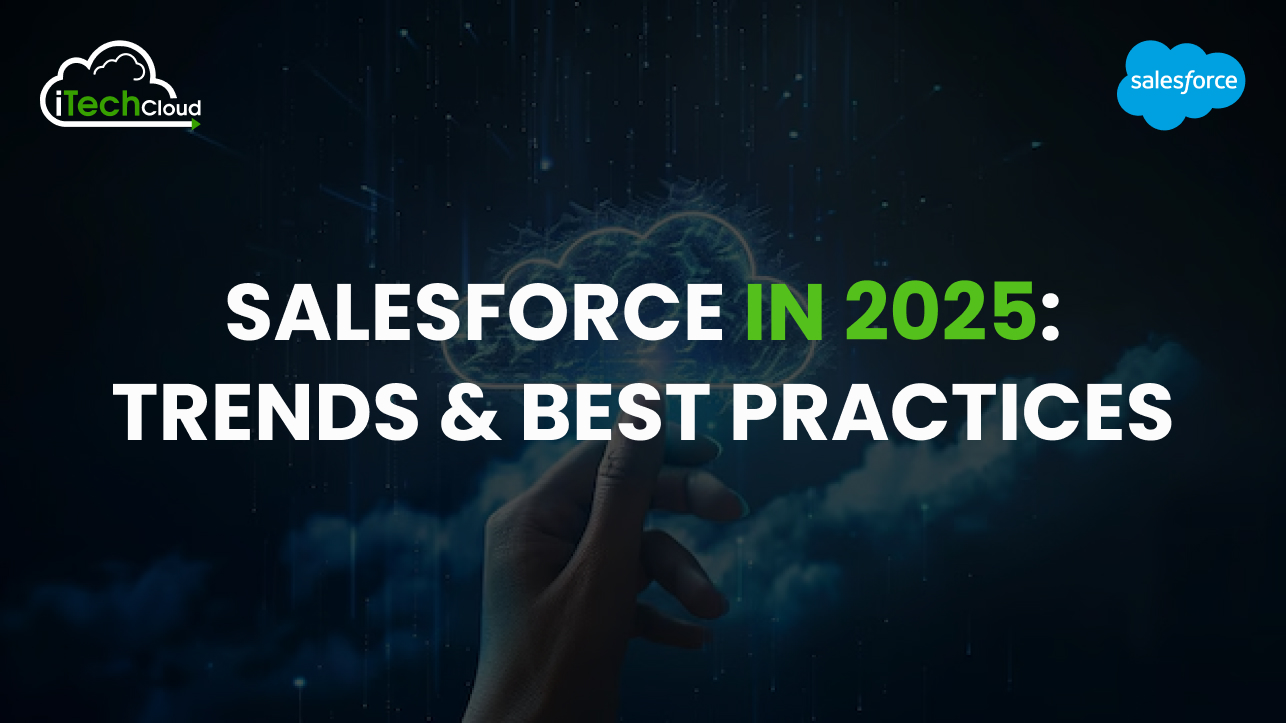Salesforce continues to be a game-changer in the world of customer relationship management (CRM), and as we enter 2025, the platform is evolving at an unprecedented pace. With new innovations in artificial intelligence (AI), automation, and industry-specific solutions, businesses leveraging Salesforce need to stay ahead of the curve. In this blog, we explore the key Salesforce trends shaping 2025 and best practices to maximize the platform’s potential.
Key Salesforce Trends in 2025
1. AI and Automation Take Center Stage
Salesforce has been aggressively integrating AI into its ecosystem with tools like Einstein AI and Generative AI-powered assistants. In 2025, AI-driven insights will revolutionize the way businesses handle sales, marketing, and customer service. Companies will leverage AI for predictive analytics, chatbots, automated workflows, and enhanced data intelligence.
Key AI-Driven Features:
- Einstein GPT: A generative AI model that automates content creation, customer interactions, and data analysis.
- AI-Powered Sales Forecasting: More precise forecasting using real-time insights and predictive analytics.
- Automated Workflows: Advanced automation of repetitive tasks, freeing up employees to focus on strategic initiatives.
2. Hyper-Personalization Through Data Cloud
Salesforce Data Cloud (formerly Customer Data Platform) is playing a crucial role in delivering hyper-personalized experiences. Companies are leveraging real-time data from multiple sources to craft individualized customer journeys. Expect:
- Real-Time Data Processing for immediate decision-making.
- Unified Customer Profiles for 360-degree visibility.
- AI-enhanced personalization in marketing campaigns, sales outreach, and customer service.
3. Industry-Specific Solutions
Salesforce’s Industry Clouds (e.g., Financial Services Cloud, Health Cloud, Manufacturing Cloud) continue to expand, offering tailored solutions for different verticals. In 2025, more businesses will adopt these industry-specific offerings to streamline operations and enhance compliance.
Key enhancements include:
- Deeper AI integrations for sector-specific analytics.
- Improved regulatory compliance tools to align with evolving laws.
- Customizable workflows that cater to industry-specific needs.
4. Low-Code and No-Code Development
With the rise of Salesforce Lightning and Flow Builder, businesses are increasingly adopting low-code and no-code solutions to reduce dependency on developers. Salesforce’s Click, Not Code approach allows users to create custom applications, automate processes, and integrate third-party solutions without extensive coding knowledge.
Key tools include:
- Flow Orchestrator for automating complex business processes.
- Lightning App Builder for drag-and-drop application development.
- Mulesoft Composer for seamless API integrations.
5. Seamless Integrations with Third-Party Tools
Salesforce continues to enhance its integration capabilities, particularly with Mulesoft and Slack. In 2025, we will see an increased emphasis on creating a connected digital ecosystem that ensures seamless data sharing and collaboration.
Popular integrations include:
- Slack-First Salesforce: AI-powered workflows within Slack for enhanced team productivity.
- Mulesoft’s API-Driven Approach: Facilitating integrations with ERP, marketing automation, and e-commerce platforms.
- Third-Party Marketplace Expansions: More AppExchange solutions for various business needs.
6. Advanced Security and Compliance
With increasing cyber threats, Salesforce is enhancing its security features to ensure data protection. Zero Trust Architecture, AI-driven threat detection, and enhanced identity management tools will dominate in 2025.
Security enhancements include:
- Salesforce Shield: Advanced encryption, event monitoring, and field auditing.
- Multi-Factor Authentication (MFA): Strengthening user authentication processes.
- GDPR & CCPA Compliance Tools: Helping businesses stay compliant with evolving data regulations.
7. Sustainability and Ethical AI
Salesforce has been a leader in sustainability, and in 2025, Net Zero Cloud will be a key offering for businesses looking to track and reduce their carbon footprint. Ethical AI practices will also be prioritized to ensure transparency and fairness in AI-driven decision-making.
Sustainability Initiatives:
- Net Zero Cloud for carbon tracking and reporting.
- Sustainable Supply Chain Management tools.
- AI Ethics Board ensuring responsible AI usage.
Best Practices for Maximizing Salesforce in 2025
1. Invest in AI and Automation
To stay competitive, businesses should:
- Implement Einstein AI for predictive analytics and customer insights.
- Automate workflows using Salesforce Flow and Process Builder.
- Leverage chatbots and virtual assistants for improved customer service.
2. Prioritize Data Quality and Governance
Data is the backbone of Salesforce, and maintaining high-quality data is crucial. Best practices include:
- Regular Data Audits to remove duplicates and outdated records.
- AI-Based Data Cleansing Tools for Accuracy.
- Strong Data Governance Policies to maintain compliance.
3. Utilize Salesforce’s Industry Clouds
Businesses should explore Industry-Specific Solutions to optimize operations. For example:
- Healthcare Organizations should implement Health Cloud for patient management.
- Financial Institutions can use the Financial Services Cloud for enhanced advisory services.
- Manufacturers can benefit from Manufacturing Cloud for streamlined supply chain operations.
4. Optimize User Adoption with Training
Salesforce’s vast capabilities can be overwhelming, making continuous training essential:
- Use Trailhead for structured learning paths.
- Conduct internal workshops and certifications to upskill employees.
- Implement Salesforce Adoption Dashboards to track usage and engagement.
5. Strengthen Integration Strategies
A connected tech stack enhances productivity and efficiency. Best practices include:
- Utilizing Mulesoft for API-driven integrations.
- Embedding Slack workflows for real-time collaboration.
- Leveraging third-party tools like marketing automation and ERP software.
6. Focus on Security and Compliance
With increasing cyber threats, businesses should:
- Implement Salesforce Shield for advanced security.
- Enforce MFA and role-based access controls.
- Regularly update security policies to comply with regulations.
7. Leverage Sustainability Tools
Companies aiming for ESG (Environmental, Social, and Governance) goals should:
- Use Net Zero Cloud for carbon emissions tracking.
- Implement sustainable supply chain management tools.
- Ensure ethical AI practices in customer interactions.
Conclusion
Salesforce in 2025 is all about AI-driven automation, hyper-personalization, industry-specific solutions, and enhanced security. Businesses that stay ahead of these trends and implement best practices will gain a competitive edge in their respective industries. By investing in AI, prioritizing data governance, leveraging industry clouds, and strengthening security, organizations can maximize Salesforce’s potential and drive long-term success.
As we move forward, staying updated with Salesforce innovations and continuously optimizing strategies will be key to achieving business growth and customer satisfaction. Now is the time to harness the power of Salesforce and lead the way in digital transformation!


